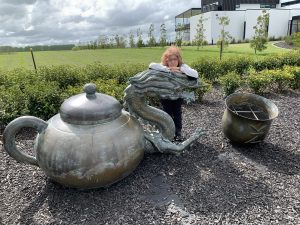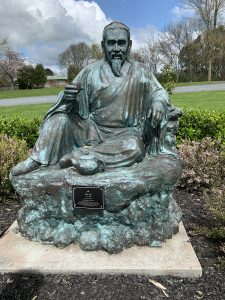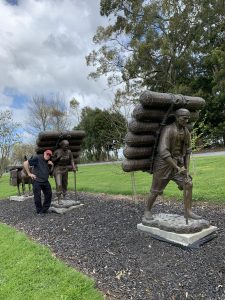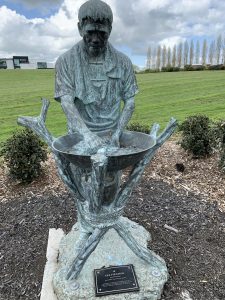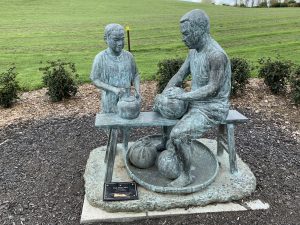Tag Archive
activity architecture art artist building Canada children city CostSaver downtown drive i-95 entertainment Europe event exhibit family festival Florida food fun historic History landmark local Museum music Nature New Zealand Ontario roadtrip sculpture Seattle show sights sightseeing tour tourist Trafalgar travel travelblogger view Washington Washington State water world
New Zealand: Gordonton – Dancing with Captain James Cook in Zealong Sculpture Garden
Captain James Cook (1778-1729) was a British adventurer who explored New Zealand. The indigenous Maori introduced him to the manuka plant as a medicinal tea. It reminded him of home.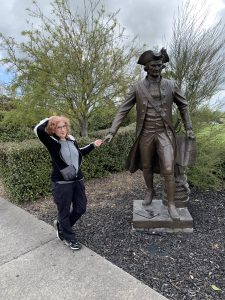
New Zealand: Gordonton – One Dragon Teapot in Gordonton, NZ
In Asia dragons and teapots are very popular for centuries. At the Zealong Tea Estate sculpture garden you learn about oolong teas and teas around the world.
New Zealand: Gordonton – Tea Pots Dragon at Zealong Tea Estate, New Zealand
A favorite sculpture in the Zealong Tea Estate sculpture garden was this long tea pot dragon with the estate building in the rear.
New Zealand: Gordonton – Sculpture of Famous Tea sage in Gordonton, NZ
It was a surprise to us to learn that there were tea sages. Here’s a sculpture of Lu Yu who performed this work way back in 733-804. Since he lived to 71, unusual back in those days, perhaps the tea is anti-aging?
New Zealand: Gordonton – Tea Worker Sculpture, New Zealand
You get an idea of the work involved in bringing tea to the table at the Zealong Tea Estate in Gordonton, NZ. Here the sculptures are getting some help from the travel media.
New Zealand: Waikato – Sculpture at Zealong Tea Estate
Along the sculpture walk at the Zealong Tea Estate in NZ, you learn that the world imbibes at least a billion cups of tea a day. It’s the world’s favorite drink (after water of course).
New Zealand: Gordonton – Zealong Tea Estate
You can visit the Zealong Tea Estate in New Zealand, walk the sculpture walk, take a tea tour, sip tea in the tea house of, of course, shop in the tea retail shop.
US: Savannah, GA – Eli Whitney Slept Here
Why not stay at a hotel that has embraces a piece of Southern history – Inn at Mulberry Grove. Mulberry Grove was the name of the plantation where Eli Whitney arrived as a tutor for widow Mrs. Nathaniel Greene’s children. Her hubby was 2nd in command to Washington, and had been given The Mulberry Grove Plantation as a gift from the spoils of the Revolutionary War.
Whitney was no average tutor. A Yale graduate, he tinkered with inventions, and recognized the need to speed up the process of separating cotton seeds from cotton fibers. He gained worldwide recognition for inventing the cotton gin, which revolutionized the South’s cotton industry. During the Civil War, General Sherman burned down Greene’s original house, but now you can stay in this Inn on the same land.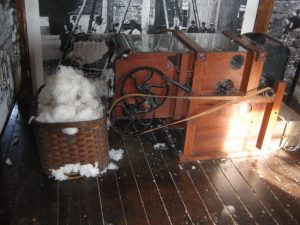
There’s a touch of European elegance here, with gilded mirrors and dark wood furnishings. The hot breakfast with sausage, biscuits, grits and waffles can be taken in the courtyard. There’s a guest laundry, and it’s budget friendly.
Location: Inn at Mulberry Grove, 101 O’Leary Road, Port Wentworth GA 31407
Tel: 912-965-9666
innatmulberrygrove.com
For Regional Information, Restaurants & Attractions: visitsavannah.com
US: Clinton, MD – Surratt House Hid Lincoln Conspiracy
If you are interested in Civil War History and conspiracy theories then the Surratt House Museum is a must for you.
Historic Surratt House has national significance due to its role in the dramatic events surrounding the Lincoln assassination conspiracy and the involvement of Mary Surratt.
As you enter the side door of this house, you are walking in the path of John Wilkes Booth the night he killed President Lincoln, since he came here to retrieve a rifle, field glasses and supplies for his run from the law. Mrs. Surratt became the first woman put to death by the United States government for her complicity.
The house was built in 1852 as a middle-class farm home for the family of John and Mary Surratt. It was more than a family home – the Surratt House also served as a tavern, public dining room and hotel for traveling gentlemen. Outside, the house was the focal point of a 300-acre plantation. A livery stable and nearby blacksmith shop serviced travelers, and in 1854 a post office was added to the tavern, serving the new area of “Surrattsville”. With the advent of the Civil War, the tavern became a clandestine Confederate safe house.
At the Surratt House Museum visitors take a guided tour from an
experienced docent in period clothing. Guests will not only learn of the
dramatic events surrounding the Lincoln assassination, but will learn about
daily life during the mid-19th century.
Location: 9118 Brandywine Road, Clinton, 20735
Hours: Wed thru Fri, 11am-3pm and Sat & Sun, 12 noon- 4pm . The last tour beings one half-hour before closing.
Tel: 301- 868-1121
surrattmuseum.org
For Regional Accommodations, Restaurants & Attractions: www.visitprincegeorges.com
US, VA – “12 Years a Slave” movie: Museum
VA Exit 177B: The movie, “12 Years a Slave” has a connection to a slave site, now a Virginia museum, called Freedom House Museum. In 1808, a US law outlawed the importation of slaves. Still so necessary for plantation life, clever entrepreneurs did not let this stop the sale of slaves – they simply bred them! The slaves were encouraged to have as many children as possible so they could be auctioned off.
The last slave trader at this site, James H. Birch, was the same dealer who, in the movie, paid kidnappers $250 for Solomon Northup of Saratoga Springs, NY; They then sold him into slavery in Louisiana. “What is unique about this building is it’s one of the few remaining buildings that the slave trade actually took place in.” said curator Julian Kiganda” who designed the exhibits here.
This building was once headquarters for the Franklin and Armfield Slave Pen, the largest and most successful domestic slave trading firm in America. “We will give Cash for one hundred likely YOUNG NEGROES”, read one of their ads in the Alexandria Gazette in 1828. “Persons who wish to sell, would do well to give us a call, as the negroes are wanted immediately. We will give more than any other purchasers that are in the market or may hereafter come into the market.”
Between the 1830’s and 1860’s Virginia exported more than 10,000 slaves a year to the Deep South, and the total may have reached 300,000, tearing families apart forever. The FREE museum is a must to absorb the personal stories of this black mark on the country’s history. “Everyone who comes through there, they feel moved.” says Kiganda.
Location: . 1315 Duke St., Alexandria, VA
Tel: 703-836-2858
www.freedomhousemuseum.org
